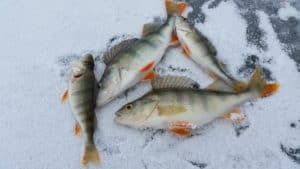Noodle Rods for Ice Fishing: Best Rod, Strengths, Weaknesses

Leave a comment after this article and let’s talk more about fishing. I’d love to read your feedback.
Ice fishing with a quality rod can make a big difference in your overall success on the ice, in particular for lighter biting fish like panfish and trout. Noodle rods are becoming increasingly more popular today because of their insane rod tip sensitivity to allow for visual bite detection.
What is a noodle rod for ice fishing? A noodle rod is a fishing rod specifically made for ice fishing that features an incredibly sensitive rod tip painted bright orange, yellow, pink, or light blue color that can easily detect even the most delicate of bites on a bait.
Fiberglass noodle rods are the most sensitive, but you can also get them made with carbon, carbon fiber, or graphite.
Find out how far apart to set ice holes for the best results.
Benefits of a Noodle Rod
A noodle rod is great for anglers who want to detect extremely delicate bites visually. They are rods with incredibly sensitive and flexible rod tips colored in a bright color for easy visual indication.
If your hands are getting cold and numb, feeling delicate bites can be near impossible. Instead, noodle rods really excel in these conditions and are a more reliable strike indicator than by feeling bites.
Noodle rods are ideal for panfish and trout fishing where bites can be subtle. They are strong enough in the backbone, though, to be able to handle stronger fish like bass, pike, and catfish if you hook into one.
Click here to learn all about ice fishing rattle reels. You may also be interested in how to catch fish with jigging rods.
Negatives of Noodle Rods

Noodle rods are perfect for fishermen that prefer to visually see bites rather than feel them. This is great if you have good vision but if you are hard of sight for whatever reason, a noodle rod would not be ideal for you.
In this case, a stiffer rod that can deliver bites all the way through your rod tip into the handle will be better.
Carbon fiber rods are better for feeling bites rather than seeing them. Also, if you are jigging with heavier baits, a stiffer carbon-type rod would be a better option.
Noodle rods can handle large fish but they are built for panfish and trout with more sensitive bites. If you are fishing for pike, walleye, or catfish, I would recommend a stiffer carbon rod instead.
Noodle Rod Materials
When it comes to ice fishing rod materials, you really have fiberglass, graphite, and carbon fiber rods. Carbon fiber rods are not very sensitive and are a bit stiffer. They, therefore, are much better for feeling a bite through the rod into the handle than they are for visually seeing a bite.
If you prefer to feel the bite, go with a stiffer carbon or carbon fiber rod. On the other end of the spectrum, fiberglass is incredibly reactive to sensitive bites and are much better for visually seeing a bite.
You won’t be able to feel a delicate bite as well with a fiberglass rod but you will definitely be able to see it. Graphite ice fishing rods are somewhere in the middle. They can be good rods themselves but won’t be as stiff as carbon rods or as visually sensitive as fiberglass.
“Feel” vs. “See” Ice Fishing Rods
When ice fishing for panfish and trout, you will be dealing with very delicate bites. There are two primary ways ice fishermen sense these subtle bites and that is by sight or by feel.
If you prefer to feel the bites, you will want a stiffer rod that will translate bites from the bait, through the line and the rod tip, right into the handle of the rod where you can feel it. Carbon-based rods will be ideal for this job.
Now if you would prefer to see the bite, a noodle rod made of fiberglass is best. These noodle rods are very tip sensitive and are painted with a bright tip so you can visually see any movement over a dark ice fishing hole.
Graphite ice fishing rods are a great “middle ground” rod because they are more touch-sensitive than fiberglass but more tip-sensitive for visual bite detection than carbon. They can be a fine option too.
If you want to learn how to locate and catch a ton of bluegills ice fishing, check out my 66 Tips for Better Bluegill Success.
If you want to learn more about using ice fishing electronics to catch more fish while ice fishing, check out my review of the iBobber castable fish finder and of the Deeper Pro + fish finder for ice fishing applications. For a complete breakdown of the best ice fishing fish finders, check out this article.
Noodle Rods vs. Spring Bobber Rods
Most often, you’re going to be much better off fishing with a noodle rod than with a spring bobber rod for panfish and trout. Noodle rods are simply better at detecting very faint bites than spring bobbers are.
Spring bobber rods are good and have their place but they cannot detect a panfish that bites your bait and swims up towards the rod tip instead of away. Too many bites are missed when this occurs with a spring bobber.
The incredibly sensitive tip of a noodle rod can and should pick up those types of bites. When sensitivity is really at a premium and fish are biting very cautiously, go with a noodle rod.
Best Noodle Rod for Ice Fishing
There are a lot of great noodle rods on the market but I love this combo by Shakespeare. It is priced very affordably and offers excellent bite detection in the tip for better early indication and more immediate hooksets.
Not only is the rod tip colored with bright color and is extremely sensitive to any change of direction, but will still be able to hold up to stronger fish like pike, chain pickerel, or catfish if you hook into one.
On top of being great for bite detection, this rod packs plenty of backbone to allow for great hooksets and the power to haul in larger fish with ease. This is a great overall rod combo for panfish and trout because you can go as light as 1 or 2-pound test line and really downsize your jig size to target those finicky fish.
Tackle, Rods, & Baits with Noodle Rods
When it comes to tackle on a noodle ice fishing rod, go as light as you can get away with. Light equals sensitivity. Go with an ultralight or lightweight spinning rod with a good gear ratio.
I recommend one with a metal turn handle instead of a plastic one that can bend and even break under tension from a large fish. For fishing line, go with light line. 1 to 6-pound test fishing is ideal for almost all ice fishing conditions unless you are specifically targeting pike or catfish.
Mono, fluorocarbon, and braid all have their perks which I cover in great detail in this article. I prefer braid because it really amps up sensitivity. You can attach a small split to get your bait down fast if deadsticking, otherwise use the lightest jighead or jig possible.
You may need to go a little heavier in deeper water to get your bait down, but try to fish with as light of bait as possible to maximize your noodle rod’s sensitivity.
Line Guides: Tiny vs. Wider
When it comes to the line guides on an ice fishing rod, many of them come in extremely narrow openings while others are much wider. The narrower guides make the rod appear much more streamlined and can be associated with quality but they aren’t a guarantee of a better option.
Narrow line guides are more susceptible to the formation of ice impacting the line and potentially cutting the line under tension. Wider line guides will still accumulate ice but you’ll have a lot more leeway before your line gets impacted.
Narrower guides are great for ice fishermen who fish inside huts, tents, or shacks on the ice because the warmer indoor temps and lack of wind will prevent ice from really building up.
Whereas if you tried to use that same rod out in the open with the cold and wind, you’d quickly run into problems.
While wider guides are still great for indoor hut fishing, they really shine outdoors for tournament anglers, for ice hopping in search of moving fish, and for those without an ice hut. Wider line guides are simply a more versatile option.
Related Questions
Are noodle rods good for deadsticking?
Noodle rods are ideal for deadsticking live or dead bait. By deadsticking, we mean essentially letting your bait suspend directly beneath the rod tip deep underwater without jigging or applying action to the bait.
Because noodle rods have such sensitive tips, you will be able to visually see not only the taps of a swimming baitfish but any bite applied by the desired gamefish on your bait. Noodle rods are ideal for deadsticking.
Do you recommend a spinning or fly rod reel with a noodle rod?
I recommend using an ultralight spinning reel on a noodle rod. A new trend in ice fishing is anglers putting a fly rod reel onto an ice fishing rod. Fly rod reels are incredibly good at managing drag and being smoothe when a strong fish is pulling.
The drag part is the biggest reason for wanting a fly rod reel. But I recommend using a standard ultralight spinning reel because it will give you better control over how fast line comes off your spoil through the drag and it will allow for better fish-fighting torque.
